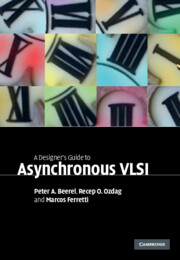Book contents
- Frontmatter
- Contents
- Acknowledgments
- 1 Introduction
- 2 Channel-based asynchronous design
- 3 Modeling channel-based designs
- 4 Pipeline performance
- 5 Performance analysis and optimization
- 6 Deadlock
- 7 A taxonomy of design styles
- 8 Synthesis-based controller design
- 9 Micropipeline design
- 10 Syntax-directed translation
- 11 Quasi-delay-insensitive pipeline templates
- 12 Timed pipeline templates
- 13 Single-track pipeline templates
- 14 Asynchronous crossbar
- 15 Design example: the Fano algorithm
- Index
- References
1 - Introduction
Published online by Cambridge University Press: 26 February 2010
- Frontmatter
- Contents
- Acknowledgments
- 1 Introduction
- 2 Channel-based asynchronous design
- 3 Modeling channel-based designs
- 4 Pipeline performance
- 5 Performance analysis and optimization
- 6 Deadlock
- 7 A taxonomy of design styles
- 8 Synthesis-based controller design
- 9 Micropipeline design
- 10 Syntax-directed translation
- 11 Quasi-delay-insensitive pipeline templates
- 12 Timed pipeline templates
- 13 Single-track pipeline templates
- 14 Asynchronous crossbar
- 15 Design example: the Fano algorithm
- Index
- References
Summary
Innovations in mobile communication, e-commerce, entertainment, and medicine all have roots in advances in semiconductor processing, which continually reduce the minimum feature size of transistors and wires, the basic building blocks of chips. This continual reduction supports ever-increasing numbers of transistors on a single chip, enabling them to perform increasingly sophisticated tasks. In addition, smaller transistors and wires have less resistance and capacitance, enabling both the higher performance and lower power that the integrated circuit market continually demands.
These manufacturing advances, however, also change the design challenges faced by circuit designers and the computer-aided-design (CAD) tools that support their design efforts. Beginning in the 1980s, wire resistance became an important factor to consider in performance and is now also important in analyzing voltage drops in power grids and long wires. Starting in the 1990s, higher mutual capacitance exacerbated the impact of cross-talk, which is now addressed by a new range of timing and noise analysis tools. And today, as the transistor's feature size approaches fundamental atomic limits, transistors act less like ideal switches and wires act less like ideal electrical connections. In addition, the increased variations both within a single chip and between chips can be substantial, making precise estimates of their timing and power characteristics virtually impossible. Consequently, modern CAD tools must conservatively account for these new non-ideal transistor characteristics as well as their variability.
As part of this ever-changing technological backdrop, the relative merits of different circuit design styles change.
Information
- Type
- Chapter
- Information
- A Designer's Guide to Asynchronous VLSI , pp. 1 - 15Publisher: Cambridge University PressPrint publication year: 2010
